The Chromatin Immunoprecipitation Testing Market is estimated to be valued at USD 2.1 billion in 2025 and is projected to reach USD 4.3 billion by 2035, registering a compound annual growth rate (CAGR) of 7.3% over the forecast period.
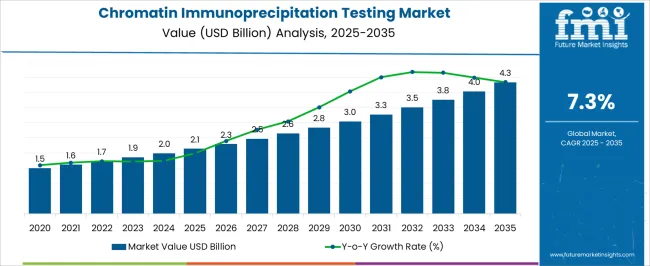
| Metric | Value |
|---|---|
| Chromatin Immunoprecipitation Testing Market Estimated Value in (2025 E) | USD 2.1 billion |
| Chromatin Immunoprecipitation Testing Market Forecast Value in (2035 F) | USD 4.3 billion |
| Forecast CAGR (2025 to 2035) | 7.3% |
The Chromatin Immunoprecipitation Testing market is experiencing steady momentum as researchers continue to emphasize advanced molecular techniques for gene regulation and epigenetic studies. The demand for more precise and reproducible testing tools has significantly increased due to the rising prevalence of cancer, neurodegenerative disorders, and autoimmune diseases that are closely linked with epigenetic modifications. Growth is further supported by increased adoption of high-throughput sequencing platforms, which require accurate chromatin immunoprecipitation methods as preparatory steps.
The ability of these tests to provide deeper insights into protein DNA interactions is paving the way for drug discovery, biomarker development, and personalized medicine applications. Investments in life science research infrastructure and increased funding in genomic and proteomic studies are also shaping future demand.
With advancements in reagents, consumables, and assay kits, laboratories and research institutes are better equipped to conduct complex analyses, creating a foundation for sustained growth As precision medicine continues to expand, chromatin immunoprecipitation testing is anticipated to play an integral role in providing clinically relevant molecular insights.
The chromatin immunoprecipitation testing market is segmented by product type, chip type, application, end users, geography, and geographic regions. By product type, chromatin immunoprecipitation testing market is divided into Protein A Magnetic Beads for Chromatin Immunoprecipitation Testing and Protein G Magnetic Beads for Chromatin Immunoprecipitation Testing. In terms of chip type, chromatin immunoprecipitation testing market is classified into XChIP and NChIP. Based on application, chromatin immunoprecipitation testing market is segmented into Cancer, Cardiovascular Diseases, Central Nervous Disorders, and Others.
By end users, chromatin immunoprecipitation testing market is segmented into Research Institutes, Hospitals, Diagnostic Centers, and Others. By geography, chromatin immunoprecipitation testing market is segmented into North-America, Eastern Europe, Western Europe, Asia-Pacific Excluding China & Japan, China, Japan, Middle East And Africa, and Latin America. Regionally, the chromatin immunoprecipitation testing industry is classified into North America, Latin America, Western Europe, Eastern Europe, Balkan & Baltic Countries, Russia & Belarus, Central Asia, East Asia, South Asia & Pacific, and the Middle East & Africa.
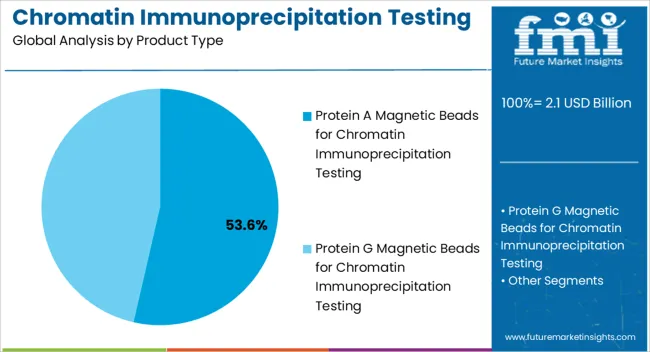
The Protein A Magnetic Beads product type is projected to hold 53.60% of the Chromatin Immunoprecipitation Testing market revenue in 2025, making it the leading product segment. This dominance is being attributed to the superior binding affinity and specificity offered by magnetic beads, which enhance the accuracy of immunoprecipitation assays. The segment has been favored in laboratories due to its efficiency in isolating chromatin complexes with minimal sample loss and contamination.
The ease of automation and compatibility with high-throughput platforms have further accelerated adoption in both academic and clinical research settings. In addition, the ability of protein A magnetic beads to streamline workflows and reduce assay time has been instrumental in ensuring reliable results across large sample sizes.
Growing demand for reproducible and scalable solutions in molecular biology has created strong momentum for this product type With increasing investment in oncology and epigenetic research, this segment is expected to maintain its leadership position through innovations that support faster and more cost-effective experimental outcomes.
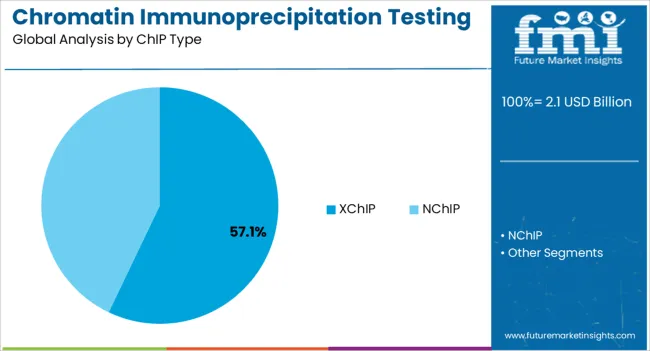
The XChIP technique is anticipated to capture 57.10% of the Chromatin Immunoprecipitation Testing market revenue in 2025, representing the most widely utilized method within this field. The strong preference for this approach is being driven by its ability to preserve protein DNA interactions during the crosslinking process, which ensures highly accurate mapping of chromatin binding sites.
The dominance of XChIP has been reinforced by its broad applicability in next-generation sequencing workflows, enabling comprehensive profiling of transcription factors, histone modifications, and regulatory proteins. Laboratories have increasingly adopted this method due to its capacity to deliver consistent results even from limited biological material.
Its compatibility with both small and large-scale studies has further positioned it as the preferred choice in genomics and epigenetics research The rising demand for detailed functional analysis of regulatory elements in cancer and developmental biology is accelerating adoption of XChIP, as it supports a deeper understanding of gene expression regulation and disease pathogenesis.
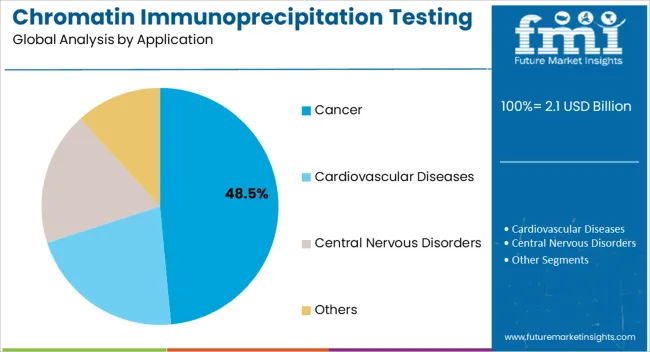
The Cancer application segment is expected to hold 48.50% of the Chromatin Immunoprecipitation Testing market revenue in 2025, underscoring its central role in driving demand for this technology. Growth in this segment is being fueled by the rising global cancer burden and the urgent need to identify novel biomarkers and therapeutic targets. Chromatin immunoprecipitation testing has been widely applied to study epigenetic modifications that regulate oncogene activation and tumor suppressor silencing, which are critical for understanding cancer progression.
The ability of these tests to reveal molecular mechanisms underlying treatment resistance and metastasis has further strengthened their role in oncology research. As pharmaceutical companies increase their focus on precision oncology, the reliance on ChIP assays for preclinical validation and drug development is intensifying.
Academic and clinical research institutions are also prioritizing epigenetic profiling in cancer studies, supported by significant research funding With continued innovation in assay kits and sequencing technologies, this segment is expected to sustain its dominant position by addressing the unmet need for deeper molecular insights in cancer diagnostics and therapeutics.
A legion of biological processes like DNA recombination and replication, gene transcription, DNA repair, chromosomal stability, chromosome segregation, epigenetic silencing, cell cycle progression, and regulation of gene expression are mediated through protein–DNA interactions. Chromatin Immunoprecipitation testing is a method for investigating the DNA-protein interaction. Chromatin Immunoprecipitation also referred as ChIP, is a type of tool that helps in determining the location of the DNA binding sites on the genome for a protein of interest. Chromatin Immunoprecipitation is generally more of a qualitative approach than a quantitative one.
Chromatin Immunoprecipitation testing also helps in determination of particular location in the genome that certain histone modifications are linked with, which further indicates targets for histone modifiers. Chromatin Immunoprecipitation is also used for the study of protein modification site or transcriptional factor binding site. With the development of Next Generation Sequencing, the combination of Chromatin Immunoprecipitation and Next Generation Sequencing, Chromatin Immunoprecipitation Sequencing (ChIP-Seq), is now capable of screening and identification of the protein binding sites on the complete chromosomal scale with high and improved accuracy and efficiency.
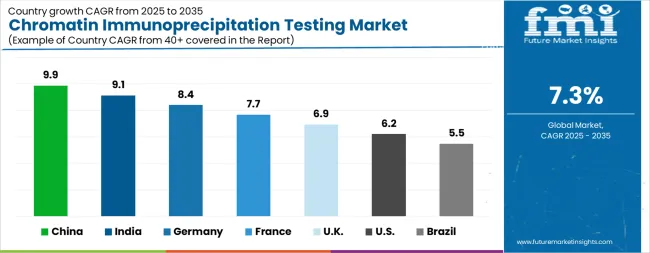
| Country | CAGR |
|---|---|
| China | 9.9% |
| India | 9.1% |
| Germany | 8.4% |
| France | 7.7% |
| UK | 6.9% |
| USA | 6.2% |
| Brazil | 5.5% |
The Chromatin Immunoprecipitation Testing Market is expected to register a CAGR of 7.3% during the forecast period, exhibiting varied country level momentum. China leads with the highest CAGR of 9.9%, followed by India at 9.1%. Developed markets such as Germany, France, and the UK continue to expand steadily, while the USA is likely to grow at consistent rates. Brazil posts the lowest CAGR at 5.5%, yet still underscores a broadly positive trajectory for the global Chromatin Immunoprecipitation Testing Market. In 2024, Germany held a dominant revenue in the Western Europe market and is expected to grow with a CAGR of 8.4%. The USA Chromatin Immunoprecipitation Testing Market is estimated to be valued at USD 810.3 million in 2025 and is anticipated to reach a valuation of USD 1.5 billion by 2035. Sales are projected to rise at a CAGR of 6.2% over the forecast period between 2025 and 2035. While Japan and South Korea markets are estimated to be valued at USD 102.7 million and USD 60.5 million respectively in 2025.
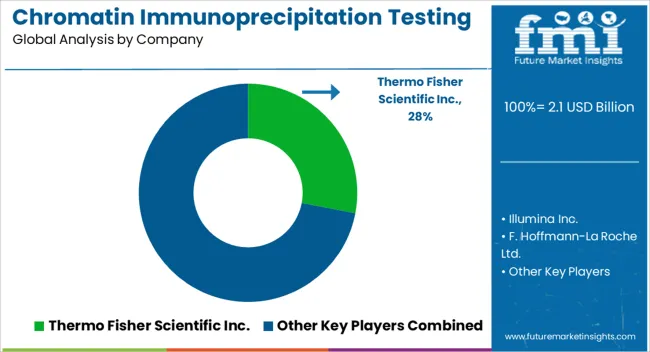
| Item | Value |
|---|---|
| Quantitative Units | USD 2.1 Billion |
| Product Type | Protein A Magnetic Beads for Chromatin Immunoprecipitation Testing and Protein G Magnetic Beads for Chromatin Immunoprecipitation Testing |
| ChIP Type | XChIP and NChIP |
| Application | Cancer, Cardiovascular Diseases, Central Nervous Disorders, and Others |
| End Users | Research Institutes, Hospitals, Diagnostic Centers, and Others |
| Geography | North-America, Eastern Europe, Western Europe, Asia-Pacific Excluding China & Japan, China, Japan, Middle East And Africa, and Latin America |
| Regions Covered | North America, Europe, Asia-Pacific, Latin America, Middle East & Africa |
| Country Covered | United States, Canada, Germany, France, United Kingdom, China, Japan, India, Brazil, South Africa |
| Key Companies Profiled | Thermo Fisher Scientific Inc., Illumina Inc., F. Hoffmann-La Roche Ltd., Merck KGaA, Agilent Technologies Inc., Bio-Rad Laboratories Inc., Qiagen N.V., and BGI Genomics Co. Ltd. |
The global chromatin immunoprecipitation testing market is estimated to be valued at USD 2.1 billion in 2025.
The market size for the chromatin immunoprecipitation testing market is projected to reach USD 4.3 billion by 2035.
The chromatin immunoprecipitation testing market is expected to grow at a 7.3% CAGR between 2025 and 2035.
The key product types in chromatin immunoprecipitation testing market are protein a magnetic beads for chromatin immunoprecipitation testing and protein g magnetic beads for chromatin immunoprecipitation testing.
In terms of chip type, xchip segment to command 57.1% share in the chromatin immunoprecipitation testing market in 2025.






Full Research Suite comprises of:
Market outlook & trends analysis
Interviews & case studies
Strategic recommendations
Vendor profiles & capabilities analysis
5-year forecasts
8 regions and 60+ country-level data splits
Market segment data splits
12 months of continuous data updates
DELIVERED AS:
PDF EXCEL ONLINE
Chromatin Immunoprecipitation Sequencing Market Size and Share Forecast Outlook 2025 to 2035
Testing, Inspection & Certification Market Growth – Trends & Forecast 2025 to 2035
5G Testing Market Size and Share Forecast Outlook 2025 to 2035
AB Testing Software Market Size and Share Forecast Outlook 2025 to 2035
5G Testing Equipment Market Analysis - Size, Growth, and Forecast 2025 to 2035
Eye Testing Equipment Market Size and Share Forecast Outlook 2025 to 2035
HSV Testing Market Size and Share Forecast Outlook 2025 to 2035
IoT Testing Equipment Market Size and Share Forecast Outlook 2025 to 2035
HPV Testing and Pap Test Market Size and Share Forecast Outlook 2025 to 2035
GMO Testing Services Market Insights – Food Safety & Regulatory Compliance 2024 to 2034
GMP Testing Services Market
LTE Testing Equipment Market Growth – Trends & Forecast 2019-2027
Drug Testing Systems Market Size and Share Forecast Outlook 2025 to 2035
Sand Testing Equipments Market Size and Share Forecast Outlook 2025 to 2035
Tire Testing Machine Market Size and Share Forecast Outlook 2025 to 2035
Self-Testing Market Analysis - Size, Share, and Forecast 2025 to 2035
Food Testing Services Market Size, Growth, and Forecast for 2025–2035
Bend Testing Machine Market Growth - Trends & Forecast 2025 to 2035
An Analysis of the Leak testing Machine Market by Detectors and Sensors Hardware Type through 2035
Soil Testing Market Growth - Trends & Forecast 2025 to 2035

Thank you!
You will receive an email from our Business Development Manager. Please be sure to check your SPAM/JUNK folder too.
Chat With
MaRIA